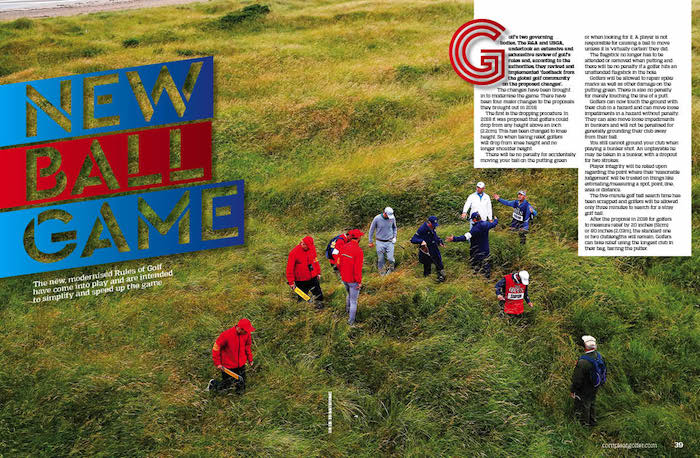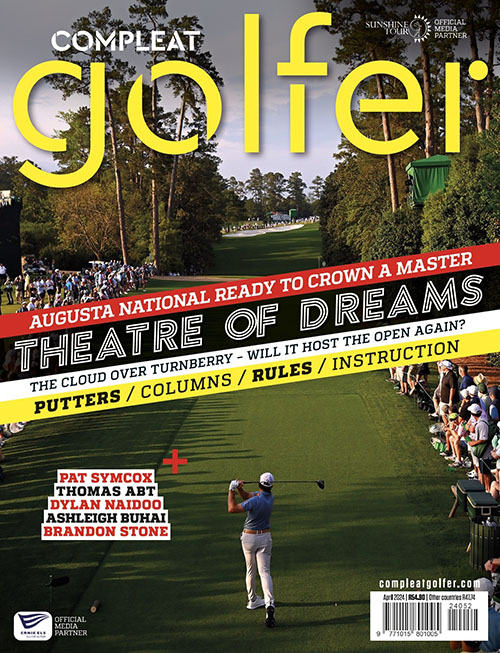The new, modernised Rules of Golf have come into play and are intended to simplify and speed up the game.
Golf’s two governing bodies, The R&A and USGA, undertook an extensive and exhaustive review of golf’s rules and, according to the authorities, they have revived and implemented ‘feedback from the global golf community on the proposed changes’.
The changes have been brought in to modernise the game. There have been four major changes to the proposals brought out in 2018.
The first is the dropping procedure. In 2018 it was proposed that golfers could drop from any height above an inch (2.2cm). This has been changed to knee height. So when taking relief, golfers will drop from knee height and no longer shoulder height.
There will be no penalty for accidentally moving your ball on the putting green or when looking for it. A player is not responsible for causing a ball to move unless it is ‘virtually certain’ they did.
The flagstick no longer has to be attended or removed when putting and there will be no penalty if a golfer hits an unattended flagstick in the hole.
Golfers will be allowed to repair spike marks as well as other damage on the putting green. There is also no penalty for merely touching the line of a putt.
Golfers can now touch the ground with their club in a hazard and can move loose impediments in a hazard without penalty. They can also move loose impediments in bunkers and will not be penalised for generally grounding their club away from their ball.
You still cannot ground your club when playing a bunker shot. An unplayable lie may be taken in a bunker, with a dropout for two strokes.
Player integrity will be relied upon regarding the point where their ‘reasonable judgement’ will be trusted on things like estimating/measuring a spot, point, line, area or distance.
The five-minute golf ball search time has been scrapped and golfers will be allowed only three minutes to search for a stray golf ball.
After the proposal in 2018 for golfers to measure relief by 20 inches (51cm) or 80 inches (2.03m), the standard one or two club lengths will remain. Golfers can take relief using the longest club in their bag, barring the putter.
There will no longer be a penalty for double-hitting a shot. Golfers will simply count the single stroke they took to strike the ball, rather than counting two shots for hitting the ball twice.
The out-of-bounds rule is set to undergo huge changes in a bid to speed up play. Golf clubs will be allowed to install a local rule that golfers can drop a new ball in the vicinity of where their ball has gone out of bounds, with a two-stroke penalty.
Golf’s governing bodies are also encouraging ready golf in stroke play and recommend that golfers take no longer than 40 seconds over a shot.
David Rickman, executive director – governance at The R&A, said: ‘We believe the new rules are more in tune with what golfers would like and they are easier to understand and apply for everyone who enjoys playing this great game.’
‘We’re very thankful to the golfers, administrators and everyone in the game who took the time to provide us with great insights and thoughtful feedback,’ said USGA senior director of rules and amateur status, Thomas Pagel. ‘We couldn’t be more excited to introduce the new rules.’
How are the new rules being received by the professionals right at the top of the food chain?
At the 2016 US Open at Oakmont, former world No 1 Dustin Johnson was asked if he had made his ball move at address on the 5th green. He told the referee at the scene he did not believe he had, but bizarrely, the USGA officials decided they could not make an immediate decision, so nobody was sure of Johnson’s score until he finished the round. He was hit with a one-shot penalty before signing his scorecard, but fortunately he was so far ahead it did not matter.
Under the new rules there would be no such farce – because there would be no penalty. ‘I think some of the rule changes are really good, especially the ball on the green when you don’t feel you caused it to move and you still get a penalty – that makes no sense to me,’ Johnson said.
‘I think they’re great,’ Rory McIlroy said of the new rules. ‘What’s happened over the past couple of years, with some rulings and high-profile things that have taken place at crucial stages in tournaments, people who might want to get into the game look at that and are like, “You know, the rules are too complicated, I don’t want to get into all that.” Making rules more modern to move with the times is good.’
Tiger Woods tweeted that it was ‘Great work to benefit the game’.
The changes were labelled ‘the biggest in a generation’ by Rickman. ‘Players were so intimidated by them that they couldn’t even open the book and try to understand,’ he said. ‘When they did open the rule book and perhaps by great skill and endeavour find the right place to look, they still managed to be confused or get it wrong.’
THEN AND NOW
Then: The flag had to be removed to let the ball fall into the hole if it was wedged next to it.
Now: The ball is classed as holed if part of the ball is below the lip.
Then: Repairing the line of putt was not allowed, apart from a few exceptions such as pitch marks and old hole plugs.
Now: You are allowed to repair nearly all damage on the green, including spike marks.
Then: If you decided to play a ball from a water hazard as it lies, you were not allowed to touch the ground or the water before your stroke.
Now: You are allowed to ground the club in or out of the water.
Then: The player incurred a penalty stroke if they moved a ball during a search.
Now: This is without penalty. You can use your feet and your clubs when searching in thick grass without consequences.
Then: A double hit, resulting in a one-shot penalty was incurred if the club got stuck when a stroke was played and, as a result, the ball was hit more than once.
Now: This is without penalty.
Then: Touching the sand in the bunker before the stroke was not allowed, except for very few exceptions.
Now: Touching the sand is allowed, although not in close proximity to your ball. However, you are still not allowed to test the condition of the sand before the stroke is played, or touch the sand during practice swings.
Then: Touching leaves, twigs, stones, branches and other loose impediments in bunkers and water hazards was not allowed.
Now: You can remove loose impediments anywhere without penalty, including in bunkers and penalty areas (new name for water hazards).
NEW NUMBERS
0 – If you hit a ball out of bounds from the tee you won’t be able to hit a provisional ball. You will walk to the point of entry where the ball went out of bounds and drop your ball at the nearest edge of the fairway and play your fourth shot from there. The issue, however, is that this is a local rule.
3 – In the ‘old’ days you were allowed five minutes to look for a lost ball. That has changed and the time spent looking has been reduced to three minutes.
24 – From 2019 there will be 24 rules, with sub-rules and sub-sub-rules, but this is down from the previous 34.
40 – This might be a tough one to enforce during an amateur day out but you can start the clock ticking on this one. No more than 40 seconds is permitted to play a stroke.
2 000 000 – That’s two million, the number of Player’s Edition books that will be distributed in the US and its territories and Mexico by the USGA, with a similar number distributed in the rest of the world by the R&A.







